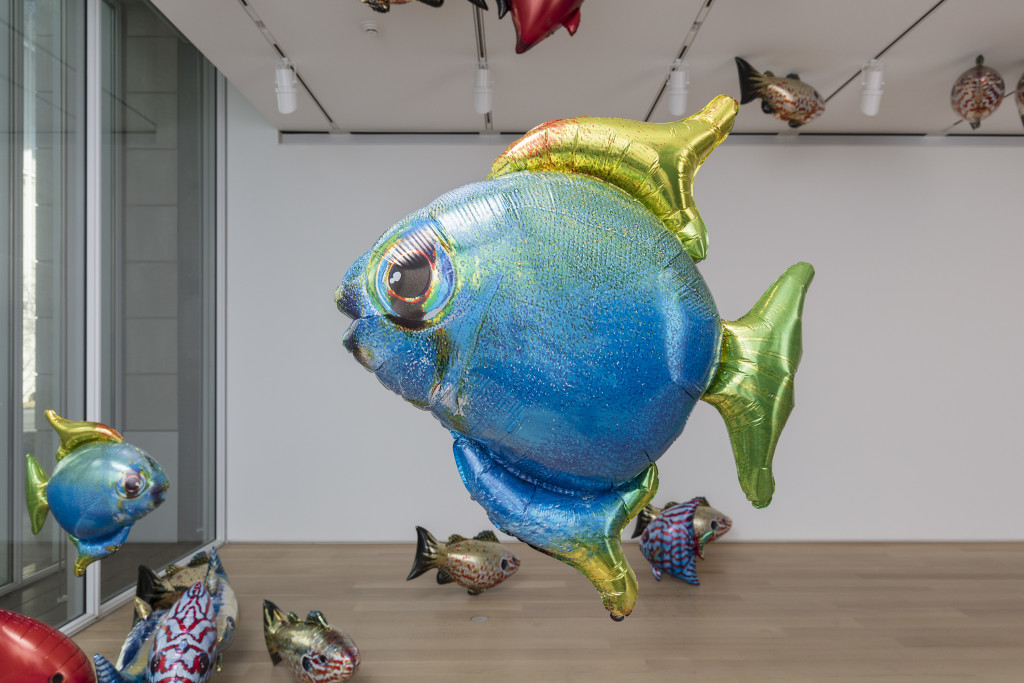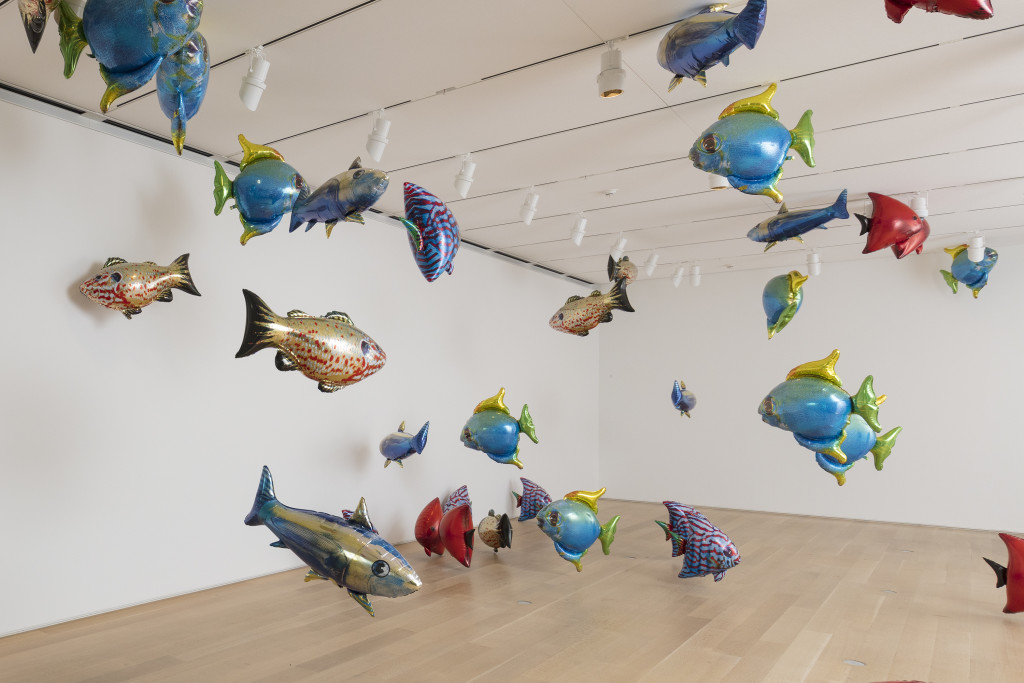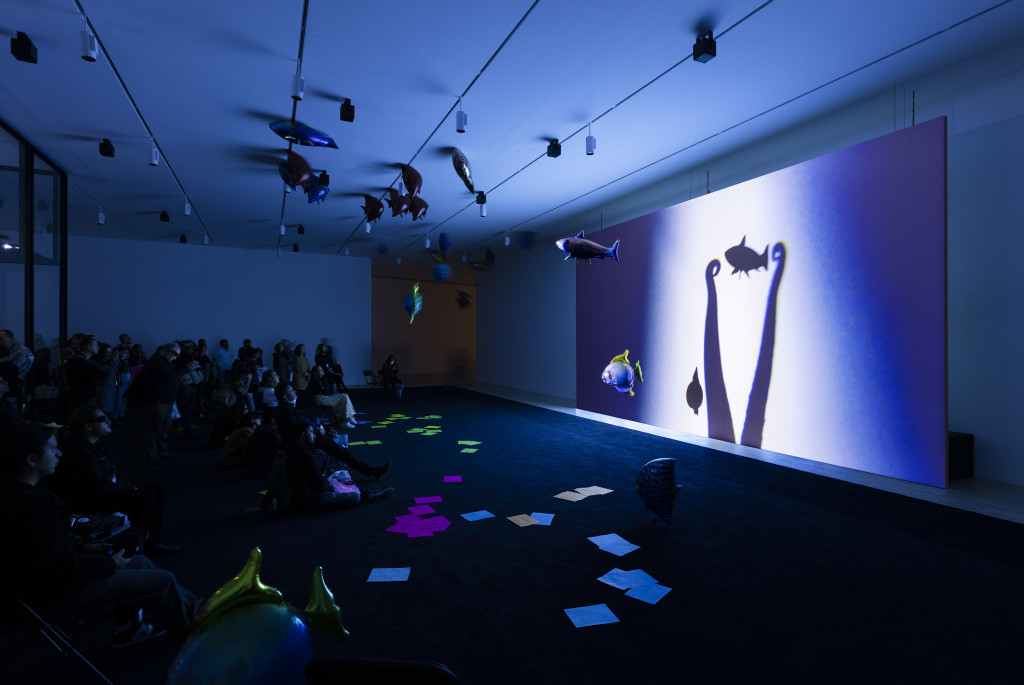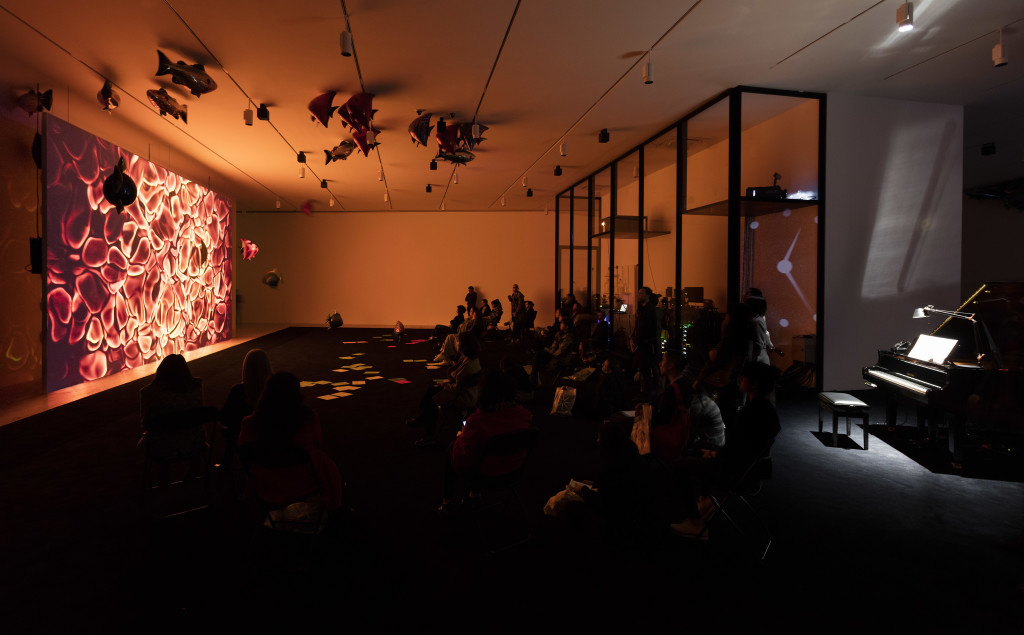Phillipe Parreno: Two Automatons for One Duet
by Natalie Hegert

Floating fish balloons are a mainstay in Paris-based artist Philippe Parreno’s current work—unable to be bound to any medium, the artist explores the object in the relationship to the space of an exhibition. Utilizing scientific technology in groundbreaking ways, Parreno most recently gave performative authority to a yeast colony in his 2017 show, La levadura y el anfi trión (The Yeast and The Host) at Museo Jumex in Mexico City. Last year marked three international solo exhibitions for the artist—Natalie Hegert sits down with Parreno to talk about his two recent exhibitions in 2018, at Martin-Gropius-Bau in Berlin and the Art Institute of Chicago, in the context of the inescapable impermanence of the ‘permanent’ object.
Natalie Hegert: The show at Martin-Gropius-Bau Berlin is a few months off still, but can you give us a little taste of what might be included in the show?
Philippe Parreno: Oh wow, my head is in it. It is far away from being done, but what I can tell you is that there are a number of elements. There will be some drawings, made mostly of iterations. They are of fireflies, or the drawings I did for the Marilyn (2012) show, the drawings of C.H.Z.1 (2011). All of these drawings show the repetition of a motif, over and over—and I have never really shown them. Since the Martin-Gropius-Bau is sort of a quieter space—not, of course, the atrium, but on the sides—there are spaces that I am using to display a large quantity of drawings.
There will be also the Fireflies project—an automation or animation element I did some time ago, where I worked with a program called The Game of Life.2 The animation was made by an algorithm, which chooses pictures of the drawings, one after another, to produce an animation, as if the fireflies are alive.
Blinds will be operating. There will be maybe the creation of some air vortex and the fish balloons underlining the installation to make the movement of air visible, and there will be elements of the water lilies pond that I did a long time ago at the Beyeler. The selection of these combined elements will form a sort of automaton. There will also be two films, I believe—one film called, Anywhere, Anywhere out of the World, which I just made a new, weird 3-D version of, and another film entitled Anyone.
As the exhibition will be staged in the summer, I will be utilizing the sunlight inside of the museum, as well as some sound pieces paired with older work. All of the events will have to be orchestrated.
NH: How do the planning stages function when you are working on an exhibition like this? As we are speaking, it is January, and the show opens in May—where are you in currently in your approach?
PP: I guess when I do any kind of show, first what I always do is look at the architecture and decide how I came to this place and how I am going to use the architecture. I make models of the space and try to see how I can articulate something within it. I have been doing that this winter, and at the end of last year I began elements that I believed could stand together, work together. From there, I slowly go into the details. For example, in the drawing section I mentioned, I am going to have to curate that. And then all the blinds are going to move.
I do not want to use any algorithms, but instead want the show to be curated and created by people, so I need operators, puppeteers, dancers to operate the events. That is the next stage for me. First, the architecture, then to see what kind of physical objects—even if they are films—I want to put in it. Slowly you build it up in layers.
NH: I want skip ahead to a question I have about architecture and how you work with it—is there a kind of architecture you prefer to work with at this point, now that you have done the Turbine Hall, installations at fairs, as well as other museums and galleries?
PP: I am more drawn to working with spaces where I do not have to fight against the architecture. The Palais de Tokyo was complicated because it was vast, and also a quite visually chaotic—it is really hard to find order within its structure. It is easier, for example, to use a classic museum space. But it would be less fun. Since what I do is always a map of negotiations, the production and form is a byproduct of this process. I find singularities each time I am invited to do an exhibition, and a space in a way—the proposal, my reading of the space—dictates different forms. The more diverse and inspirational the spaces are, the more I try to work in a topological way, spending a lot of time within them. And since all the spaces are different, they produce a sort of different duration.
NH: Have you worked much outside?
PP: Not much—no. In parks, you mean?
NH: Yes, or any sort of outdoor area?
PP: Not really, no.
NH: Is that something that you would be interested in?
PP: Yes, but then again, I have always been more excited about exhibitions. If you go into a park, it does not have walls. And then there would have to be a guard there, so thus far, it has not really happened for me. Though, I am working on a few ideas along that line: to do something permanent would be quite nice. I am always a guest in situations, I am invited, not necessary eternal. An installation with a longer duration would be interesting. And there is a paradox here. For example, I have always been inspired by this play by Eugène Ionesco, La Cantatrice Chauve [or The Bald Soprano] that was premiered in the 1950s and was played over and over every week by the same actors. I have always thought it was fascinating, because, over time the actors knew it so well that the play itself changed. It became alive. Yet, for me, there is always an exhibition: a beginning and an end, and then I start again. It would be nice to do something that morphs over time, on a longer span than three months.

NH: I would like to talk a little bit about that idea of permanence. The indoor-outdoor commission that was just unveiled in September at the Walker, the press release says it is the first permanent public artwork of yours, no?
PP: Yes, this is true.
NH: So, it also describes it as a living sculpture, you know, it is moving—
PP: Yes, it reacts to the cloud movement. There is always a kind of animistic side to my work, you know? The fact that both weight and repetition start to produce a sense of light has always been a fascination for me. I think the practice of art, in a way, is to engage yourself with an animistic approach. For the sculpture at the Walker [The Marquis and the Sisters, (2016-17)], the movement of the blinds follows the movement of the clouds. Since the blinds operate in front of windows and look out to the sculpture garden, I thought it would be quite interesting to link the light movement outside with the blinds within the galleries. The work is reacting to its natural surroundings.
NH: As a ‘permanent’ artwork then, I guess my question was looking at the ideas of it being living and moving, yet also permanent.
PP: You see, when you say that, there is an inherent paradox in the statement. Say for example, you make a painting—one could say the circumstance would not be much different. A painting exists to be shown in museums, at least for a while, so we say that “painting is permanent,” or has that nature. And yes, it is permanent, but only through the negotiations that the institution has with history. The painting will be visible, and then not visible. There is no art object that escapes having this stochastic dimension. Everything appears and disappears—whether it is the artist, the institution, or history who decides. In this way, an art object for me is always a ‘quasiobject’— it always has to negotiate its permanency; throughout time, throughout space. So, even this piece will not always be permanent—the Walker will decide to move it, or to store it, but in the meanwhile, it is affected by its surrounding. If the piece were to disappear completely, for example if they decide to take it away and reinstall it later, that too will be a part of its life.
NH: When you first started working as an artist, you were very concerned with the idea of the dematerialization of the art object. Has your view on this changed?
PP: No—the reason why at the beginning [of my career] I used videos was that I was interested in what happens when the room contains a machine, or there is a form to see. And what happens when there is nothing to see? Do you wait within the space until something appears? All of these things were interesting to me—the fact that there is something, yet sometimes nothing.
I also remember at the beginning, because of the technology that was available, the videos had to be rewound, so there had to be time for that. I kind of liked it, the fact that you had to use electrical relays to switch the lights on and off and the tape would be rewound. That waiting was interesting to me, You are right, I was trained to be a conceptual artist. It is such a Duchampian question, which is still quite essential to my practice, even today.

2018. Photo: © Andrea Rossetti.
NH: Thank you for reminding me about rewinding tapes! It has been so long. Earlier when you were talking about the exhibition at Martin-Gropius-Bau, you said you were trying not to use any algorithms in this exhibition. Why are you avoiding them in this instance?
PP: Well, it is not that I use algorithms particularly often—I usually use a soundtrack of a media file for a piano, of Stravinsky’s Petrouchka. I never really used algorithms, the only one I used was for the piece with the fireflies, which I mentioned, called The Game of Life. It is a really simple game with few rules, devised to appear on a grid, and the grid would be on an LED screen, which was made of pixels. At the Tate [for Anywhen (2016–17), Hyundai Commission in Turbine Hall], it was more of a pre-designed sequence, but it was always dependent on its surroundings.
That is something I have been seeming to do, more and more, but now I would like to have more puppeteering, or players. That is why I was referring to that play by Ionesco and its progression, because at the beginning, a show can also have a certain form, and the better the person is at playing an instrument, the better the show will become. The space or the exhibition becomes an instrument. It is intimate and linked to the player. This figure for me came from the Indonesian tradition of shadow puppets [wayang performance], which are operated by people called dalangs, who are the puppeteers, but they actually do everything. They operate the movement of the puppets, conduct the orchestra, do the voice of the puppets, and can perform like that for hours. I like this idea more and more—that my exhibitions will be operated by that kind of character: a dalang.
NH: So not necessarily by movements of the public or the viewers, but by somebody behind the scenes?
PP: No, I never really use that method. I was more fascinated instead by this idea of non-paradox cycle: something that can be repeated, but is never the same. That is why I always link the appearances of a film in a space to a sunray outside, or to the wind— it is just to create a sort of randomness: which is a preciseness produced not by algorithms, but rather by our surroundings.
NH: I am curious if you have any thoughts on artificial intelligence, and if that is something you could see being incorporated into your work? Like, having an exhibition that ‘learns’ something.

2018. Photo: © Andrea Rossetti.
PP: I am not an expert on that. All the elements in my show work on power and on energy, which leads somewhere: the cables go somewhere. The question this raises is: who is in control of those energies? Of everything? Algorithms can be quite helpful, but they can also become agents of fear. It is always being operated by somebody. That is maybe on the dark side, but on the other, they are also objects. I do not know much about deep learning or paranoia…I tried it once or twice to see how it works, because I like duration as a model for a practice of creation. I never went really far with it, so I will not make any large comments on AI.
What I do know is that I use computers, but I like to have something more intuitive at the center, which is why I like this notion of puppeteering. For example, in Mexico I did a show where I had ‘hosts’ (performers I called hosts) playing piano and talking to the public. Those hosts were also in dialogue, so to speak, with the yeast colony. The puppeteer would be playing sequences in a different order, and the yeast would try to repeat it, and sometimes fail. So, there was a dialogue between a human and non-human entity. I like this ballet or duet. It is constructions like this which are, for me, more interesting than AI.
NH: Like natural systems?
PP: Yes, I think they produce better stories in my head.
NH: Can you give any examples of new technologies that you have incorporated in your process?
PP: Well, the bioreactors were one of the things I used. We call it a ‘bioreactor’ because it reacts to the culture of the yeast and sends back information. It is a way to possess information without using an algorithm, but rather life. That is why I worked with the scientist behind it, to see how the yeast was actually in charge of controlling the exhibition, and the sequence of programming within the exhibition. The idea was to say, for example, will it be possible for the yeast to remember the choreography and dramaturgy? What we did was we exposed the yeast to the reactor within the exhibition, and when the show ended the yeast were dried, spread on paper, and sent back to the lab. When they were woken up we were trying to see if their metabolism was able to ‘remember’ the exhibition— and they did! I like that idea, of not only a written memory of an event or an exhibition, but also its impression on the colony of yeast. It became their clock, their world.
NH: That is really interesting, that they ‘remembered’ the show themselves.
PP: Yes, it is a memory within them—embodied in these creatures.
NH: I am just recalling the controversy around the exhibition of Chinese art at the Guggenheim and the use of animals in the show. I was wondering if you had any thoughts about that? I mean, yeast is a living organism, but a little bit different.
PP: Right—it is a microorganism. It is one of the things that is used in order to make bread. In a way, it is one of the first forms of domestication of living creatures. What I like about the yeast is that you have to be aware of a sense of ‘spectrality’: there are things that are invisible. Literally, we are spectral—and that affects our surroundings.